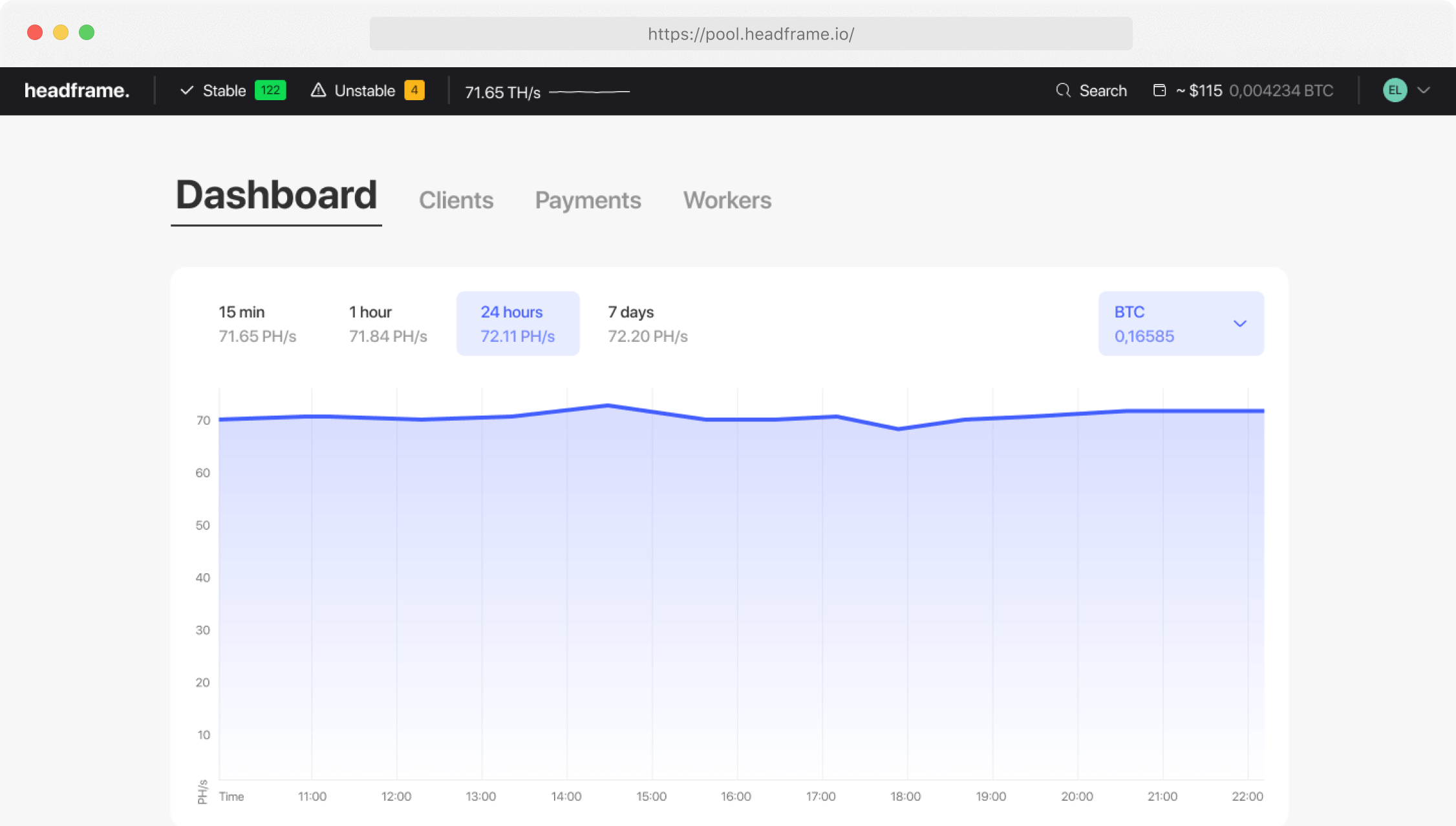Managing Large Mining Pools: Challenges and Solutions
Managing large mining pools is a complex task that requires consideration of numerous factors and overcoming various challenges. These challenges can include technical, financial, regulatory, and managerial aspects. However, with the right approach and strategies, these problems can be effectively addressed, ensuring the stable operation and growth of the mining pool. Let’s explore the main challenges faced by large mining pools and the solutions that help manage them.
Earn more money with Headframe
Join a mining pool and get the best profitability in mining. Already more than 10,000 miners trust Headframe.
Stability and Reliability
One of the primary challenges of managing large mining pools is ensuring stability and reliability. Mining pools must guarantee the uninterrupted operation of their servers and equipment, which requires significant investments in infrastructure and regular maintenance. Using modern technologies and equipment helps increase performance and reduce the likelihood of failures. For example, implementing advanced cooling systems and energy management allows for optimal working conditions for equipment, extending its lifespan and efficiency.
Resource Management
Another crucial aspect is managing the pool’s computing power. Large mining pools combine vast amounts of computational resources, making effective resource distribution critically important. Using load balancing algorithms and automated management systems helps optimize resource use and avoid overloads. This not only enhances the pool’s overall performance but also reduces electricity and maintenance costs.
Financial Management
Financial management of a large mining pool also demands special attention. High costs for equipment, electricity, and maintenance require careful control and planning. Developing and adhering to budgets, regularly analyzing financial indicators, and optimizing costs help ensure the pool’s financial stability. Transparency in financial matters also plays a significant role, strengthening the trust of participants and investors.
Regulatory Compliance
Regulatory aspects present another significant challenge for large mining pools. Different countries have their own laws and regulations regarding cryptocurrency mining, making compliance increasingly complex. The introduction of new laws and regulations may require substantial changes in pool operations. Collaboration with legal experts and active engagement with regulators help ensure compliance with all legal requirements and avoid legal issues.
Security
Security is another critically important aspect of managing large mining pools. Cyber-attacks and other threats can lead to significant losses and disrupt pool operations. Using advanced encryption methods, multi-level authentication, and regular security audits help protect pool assets and prevent unauthorized access. Investing in security and continuously updating protective systems ensure reliable protection of data and pool resources.
Human Resource Management
Human resource management also plays a vital role in the successful management of a large mining pool. Qualified specialists are needed to maintain and manage equipment, resolve technical issues, and develop strategies. Training and upskilling employees, creating favorable working conditions, and motivating staff contribute to increased productivity and efficiency.
Technological Innovations
Technological innovations and their implementation are crucial in managing large mining pools. Using advanced mining algorithms and methods, such as Proof of Work (PoW) and Proof of Stake (PoS), helps improve efficiency and reduce costs. Introducing new technologies, such as artificial intelligence and machine learning, allows for process optimization and better resource management. Continuous technological improvement and investment in research and development ensure the pool’s competitiveness and sustainable growth.
Environmental Sustainability
Environmental sustainability is becoming an important aspect of managing large mining pools. The high energy consumption of mining has a significant environmental impact, and using renewable energy sources helps reduce the pool’s carbon footprint. Investments in energy-efficient technologies and energy consumption optimization contribute to cost reduction and improved environmental sustainability.
Social Responsibility
Social responsibility and support for local communities also play a significant role in managing large mining pools. Participation in social projects, supporting local economies, and creating jobs help strengthen community ties and improve the pool’s reputation. This attracts more participants and investors, contributing to the pool’s sustainable development.
Partnerships and Collaborations
Partnerships and collaborations with other mining pools and companies also play an important role in managing large pools. Combining efforts and sharing knowledge and resources help accelerate the development and implementation of new technologies. Partnership relationships foster the creation of a global ecosystem where innovations can quickly spread and adapt to various conditions. This enhances the overall efficiency and sustainability of mining operations.
Educational Initiatives
Educational initiatives and upskilling pool participants also play a crucial role in managing large mining pools. Training miners in new methods and technologies helps improve their skills and knowledge, leading to more efficient work. Educational programs and training sessions help pool participants better understand and use modern technologies to optimize their operations. This promotes more responsible and informed participation in mining operations, enhancing their overall efficiency and stability.
In conclusion, managing large mining pools requires a comprehensive approach and consideration of numerous factors. Ensuring stability and reliability, managing computing power, financial management, regulatory compliance, security, human resource management, technological innovations, environmental sustainability, social responsibility, partnerships, and educational initiatives all play crucial roles in successfully managing a large mining pool. Understanding and applying these strategies help mining pools effectively address challenges and achieve long-term success in the cryptocurrency industry, creating a sustainable and inclusive ecosystem for all participants.


